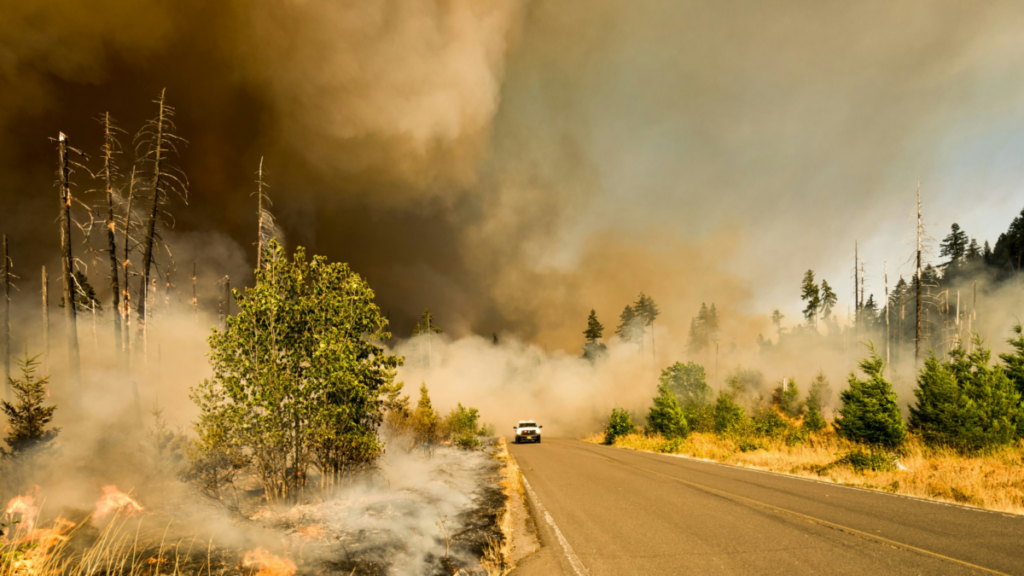Earth is burning. Can the tech industry stave off the wildfire apocalypse?

Photo by Marcus Kauffman on Unsplash
The devastating 2023 Canadian wildfire season never really ended.
Across provinces like B.C. and Alberta, ‘zombie fires’ burned throughout the winter, sometimes under a blanket of snow.
This is a stark reminder that the 45 million acres of land that burned across Canada last year — obliterating the previous annual record of 18 million acres — might just be prologue for a country where the climate is warming twice as fast as the global average.
Now, as we approach the summer of 2024, with abnormally dry conditions across many provinces, Canadian federal government officials are warning of a repeat.
Fire season is coming. And it’s expected to be bad.
Some impacts are obvious. Environmental damage. The loss of human and animal life. But wildfires and the resulting poor air quality also come with downstream impacts to business, as the Harvard Business Review noted:
“Poor air quality impacts employee health and productivity, from diminished cognitive function and poor concentration to lowered productivity and sentiment. Wildfires and smoke have disrupted corporate travel, postponed company activities, and sent employees to their doctors for a host of related health issues, including difficulty breathing.”
— Talia Varley, Harvard Business Review
There’s no silver bullet to addressing wildfire season, but over the last few years, federal and provincial governments and private companies have all started to look at ways to limit wildfire impacts using advanced technology — including everything from artificial intelligence (AI) to drones, and (eventually) even firefighting robots.
In fact, there’s now a VC firm exclusively devoted to investing in companies focused on addressing the explosion of wildfires.
The firm – Convective Capital – has already made a suite of investments in so-called ‘firetech’ companies:
“Convective has begun investing in firms that are building robots to perform the controlled burns that are essential to avoiding megafires, and in autonomous drones that can drop fire suppressants from above. Its companies are using satellites and drones to give forest managers better information to prioritize their limited resources.”
— Tim Fernholz, Quartz
The fires are here.
But so is the tech industry.
AI-driven monitoring & sensors offer immediate promise for early wildfire detection
As the saying goes, an ounce of prevention is worth a pound of cure. And the most promising firetech companies are focused on how to model, detect, and therefore limit fires before they rage out of control.
Pano AI is a California-based company that offers early wildfire detection and intelligence services to both fire departments and private companies. It installs ultra-HD rotating cameras in high vantage points of fire-prone regions and then deploys AI to analyze the resulting imagery and provide real-time updates on wildfire threats. The B.C. government installed Pano AI’s tech last fall in northern communities.
While the 2024 summer season will be the first wildfire season Pano AI’s devices are in use in Canada, the Pano AI cameras have already been successfully deployed in the U.S., Australia. The company is also planning an expansion into Europe.
How well do they work? Pano AI CEO Sonia Kastner told TechCrunch that that company was able to detect a fire in Oregon and issue a warning 14 minutes before the first 911 call about the fire ever came in.
The Insurance Bureau of Canada estimated the losses from the 2016 Fort McMurray wildfires at $4.3 billion CAD. So, while the Pano AI cameras and monitoring are significantly expensive at $50,000 USD per station, at scale they could save hundreds of millions of dollars if they’re able to detect a fire early enough for firefighters to control it. Especially because, with many wildfires, there is no 911 call until a fire is already burning way out of control.
Early fire detection isn’t even constrained to this planet anymore. The Fire Urgency Estimator in Geosynchronous Orbit (FUEGO) uses satellites orbiting Earth to monitor for fire outbreaks.
The Canadian Space Agency is also working on a $170 million CAD satellite called WildfireSat that will be focused exclusively on wildfires and will help reduce the country’s reliance on American and European satellites:
“According to the federal government, once launched the satellite will ‘improve our ability to defend Canadian communities, both to better predict fire behaviour and make decisions about evacuations, but also for things like unhealthy levels of smoke pollution and air quality.”
— David P. Ball, CBC News
WildfireSat is scheduled for launch in 2029.
Canadian Firefighter also recently reported on the current efforts to predict wildfire growth and movement with technology that has been proven out in California and Australia.
“Wildfire growth modelling works by using data from weather models, topography, and fuel maps. The technology being implemented by the BC Wildfire Service includes the ability to use existing geospatial data and fuel maps, but also uses an app-based interface to allow for on-the-ground inputs in real time. The technology includes an interface for field staff, operational decision-makers, and fire behaviour specialists who each have a unique role to play in forecasting, resource planning and fighting wildfires.”
— British Columbia Government, Canadian Firefighter
Private utilities and other companies are investing in wildfire prevention technology
While early fire identification and prevention is primarily a government responsibility, some private companies have more financial, capital, and human exposure in fire season than others.
Forestry and agricultural companies can see both their employees and products put at risk when fires rage. Insurance companies are under siege with claims as fire seasons grow more deadly each year. And private utilities bear an especially large risk with hundreds of miles of power lines and other infrastructure in their purview.
“There are some utilities that are really leaders and are getting ahead of the risk,” Michael Wara, director of the climate and energy policy program at the Stanford Woods Institute for the Environment, told National Public Radio (NPR). “And then there are others that we look at and think are walking into a catastrophe.”
The New York Times recently reported on the growing problem of utility-caused wildfires, and the risks they create, which stretch from risks to human life to damage to property, to business disruptions, to mass power outages for entire communities:
“Large wildfires started by power lines and other utility equipment were, not that long ago, considered something that happened mostly in California. But these disasters are increasingly happening in many more places as forces turbocharged by climate change like extreme heat and drought wreak havoc on electric grids that were not built or upgraded to withstand them.
Xcel Energy, a utility company based in Minneapolis, recently acknowledged that its equipment most likely started the Smokehouse Creek Fire last month in the Texas Panhandle. In August, Hawaiian Electric said one of its power lines had ignited a fire in Lahaina on the island of Maui.”
— Ivan Penn, The New York Times
Gridware says tech companies can help with this.
The company offers AI-enabled hardware devices to utilities that continuously monitor for changes that could spark wildfires. The system detects faults in real-time to enable rapid responses to ignitions so disastrous wildfires can be avoided.
Meanwhile, as some private insurers leave fire-prone markets, new tech-enabled insurance companies like Delos Insurance Solutions are stepping up. The company uses wildfire science, AI, and satellite imagery to provide homeowners’ wildfire insurance.
And this is all just the tip of the iceberg.
It’s now evident that new and advanced technology is rewriting the rules of fire management, fire insurance, and how we deal with our warming world.
Wildfires will keep growing — and so will the number of companies and technologies looking to stop them
So where is all this going?
It’s entirely reasonable to assume that a mix of sensors, drones, HD cameras and satellites will eventually provide AI-enabled fire detection for much or all of the Canadian wilderness. This is going to be our new normal.
We should also expect that advanced monitoring technologies like drones will become ever more commonplace once fires are already burning. They’ll track fire growth, help put fires out, and share data back to AI systems and humans alike.
And as financial risk grows, even more private companies will invest in bespoke solutions to reduce exposure to wildfires.
How fast all this happens is yet to be determined.
But at a time when the global demand for firefighters is being vastly outstripped by the supply, turning to technology is inevitable — and smart.
For any organization with a distributed workforce, remote or rural assets, or supply chains that could be affected by wildfires and smoke, contingency planning is increasingly going to be a mission critical priority.
Because the risks are expanding with every new fire season. And every blaze that burns beyond our ability to control it comes with potentially catastrophic consequences.
Earth is burning. Can the tech industry stave off the wildfire apocalypse?
#Earth #burning #tech #industry #stave #wildfire #apocalypse





